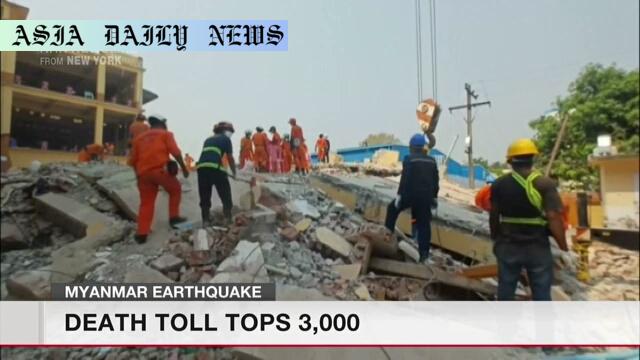Myanmar Earthquake: The death toll from the magnitude 7.7 tremor has surpassed 3,000, forcing a rare truce in the crisis-hit nation.

A Disaster of Unprecedented Proportions
The devastating earthquake that struck central Myanmar on Friday, with a magnitude of 7.7, has left a trail of unimaginable destruction and tragedy. Official reports from the country’s military administration reveal that over 3,003 lives have been lost. In addition, 4,515 individuals have sustained injuries of varying severity, and 351 remain unaccounted for amidst the chaos. Entire towns and villages have been reduced to rubble, leaving survivors scrambling for basic necessities like shelter, food, and medicine.
Given the ongoing political turmoil in the nation, the disaster has compounded the suffering of millions. Myanmar, still grappling with the aftermath of a military coup in 2021, has been largely isolated by sanctions and international condemnation. The country’s infrastructure was already fragile, and this earthquake has pushed it to the brink of collapse. Roads have been damaged, making it difficult to transport relief supplies, while hospitals are overwhelmed by the influx of injured citizens.
A Temporary Truce Amid Chaos
In an unprecedented move, Myanmar’s ruling military junta has announced a temporary ceasefire with pro-democracy forces and ethnic minority groups. The ceasefire began on Wednesday and will remain in effect until April 22, allowing for uninterrupted relief and reconstruction efforts. This rare moment of cooperation, albeit temporary, comes as a sliver of hope amidst the devastation. The military claims that relief operations are their top priority, but the international community remains wary of the junta’s long-term intentions.
Myanmar’s pro-democracy National Unity Government (NUG) has reciprocated, announcing their intention to halt fighting for two weeks. Although tensions remain high, this ceasefire underscores a shared understanding across political divides: humanitarian aid must take precedence over conflict. Aid organizations are cautiously optimistic about better access to affected regions during this truce, as the need for food, clean water, and medical supplies is urgent.
Myanmar’s International Isolation: A Roadblock to Aid
Myanmar’s current administration, led by General Min Aung Hlaing, has been largely ostracized by the global community due to its authoritarian rule and violent crackdowns on dissent. Amid this backdrop of isolation, the international response to the earthquake has been slow and limited. The junta’s restrictive policies and strained relationships with the West have further hampered relief efforts. Many Western countries have hesitated to commit significant resources, raising ethical concerns over indirectly legitimizing the military-led government.
General Min Aung Hlaing’s upcoming visit to Bangkok for a regional summit offers a crucial opportunity to bridge these gaps. He is expected to appeal for humanitarian support, an unusual step for an administration that has previously shown little interest in engaging with the international community. If successful, this could open the door to much-needed international aid. However, trust-building will be a significant challenge as donor nations weigh their options carefully.
The Road Ahead: Relief, Reconstruction, and Reconciliation
The aftermath of the Myanmar earthquake reveals not only the physical devastation caused by the disaster but also the underlying political and social fragility of the nation. Relief organizations are calling for a swift and coordinated international response to tackle the worsening humanitarian crisis. Reconstructing homes, clinics, and schools, while providing psychological support to victims, will require substantial financial and logistical resources.
For Myanmar, this disaster serves as a grim reminder of how interconnected challenges require unified solutions. Whether the temporary ceasefire can be extended into a more permanent truce remains uncertain. However, the crisis has illuminated a shared vulnerability among warring factions, underscoring the need for reconciliation and reconstruction in the face of adversity.
Commentary
The Myanmar Earthquake: A Call for Global Solidarity
The tragic earthquake in Myanmar is more than a natural disaster; it is a glaring revelation of political, social, and humanitarian shortcomings. The images of destroyed villages, overwhelmed hospitals, and grieving families depict a nation in desperate need of external support—support that is complicated by its current state of political isolation.
Humanitarian Actions Beyond Politics
One of the most striking aspects of this otherwise somber situation is the initiation of a temporary ceasefire by Myanmar’s ruling military and its opposition forces. While the ceasefire brings a glimmer of hope, it also raises questions about the sustainability of such peace efforts. Will this truce pave the way for longer-term reconciliation, or is it merely a fleeting gesture?
Unquestionably, the primary focus should now be on humanitarian efforts. Emergencies of this scale transcend political, ethnic, and ideological differences. The international community has a moral obligation to step forward, provide relief, and advocate for unhindered access to affected areas. Governments and non-governmental organizations alike must navigate the challenging political terrain to ensure that aid reaches those who need it most, regardless of the administrative framework.
Rebuilding Trust Alongside Infrastructure
For Myanmar, rebuilding should not halt at restoring its infrastructure but must extend to rebuilding trust among its people. The psychological scars left by this catastrophe are compounded by years of political instability. As the nation grapples with both immediate relief and long-term reconstruction needs, the earthquake could serve as a catalyst for much-needed dialogue and cooperation. Perhaps, in the aftermath of this tragedy, Myanmar can find a way to heal not just physically, but socially and politically as well.


